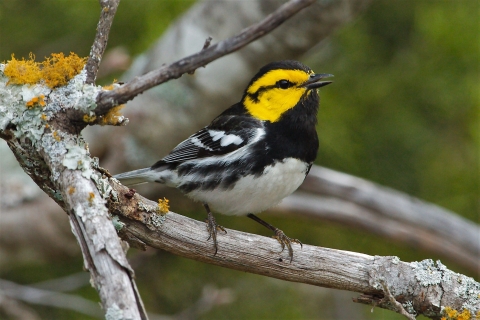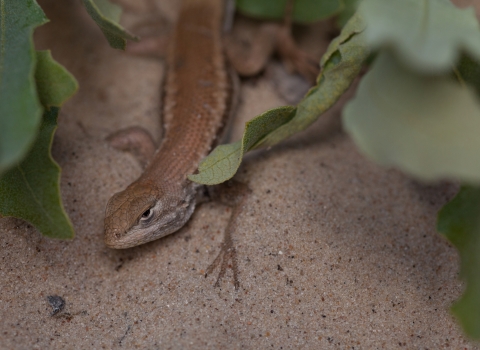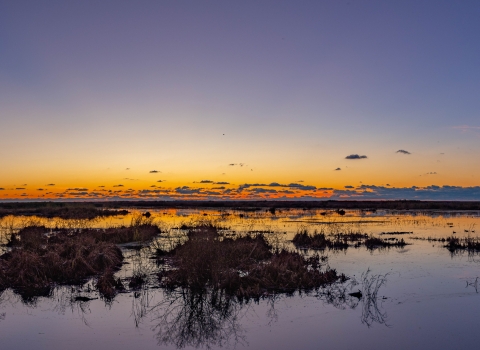After careful analysis of the best available scientific and commercial information, the U.S. Fish and Wildlife Service is announcing the completion of a five-year status review for the golden-cheeked warbler. The Service’s review recommends to the Secretary of the Interior downlisting of the species from endangered to threatened under the Endangered Species Act.
The Service conducts five-year status reviews of listed species to ensure that classifications under the ESA are current and, where appropriate, may recommend changes in status. The reviews are based on the best available scientific and commercial data and involve contributions from scientific experts, including an independent peer and technical review by federal, state, and local partners as well as academic researchers. If the recommendation were to be approved by the Secretary of the Interior, the Service would publish a proposed downlisting rule in the Federal Register, which would provide an open period for public review and comment.
During the comprehensive status review, the Service evaluated the golden-cheeked warbler’s current needs, conditions, and threats, in addition to modeling future scenarios. This comprehensive assessment of the species indicated that the golden-cheeked warbler is not currently in danger of extinction throughout all or a significant portion of its range (the definition of an endangered species in the ESA) but is instead in danger of extinction in the foreseeable future throughout its range (the definition of a threatened species in the ESA).
The five-year review concluded that the golden-cheeked warbler’s condition merits a potential change in listing status, due in part to decades of ongoing research that better clarifies our understanding of the species and its habitat conditions, and habitat conservation. While these efforts are encouraging, the review confirmed that the species and its habitat currently face ongoing threats from urbanization, drought, and wildfire, among other stressors, and will continue to do so into the future. Although the five-year status review recommends downlisting the golden-cheeked warbler to threatened status, at present, the species is still listed as endangered. The review does not result in a decision directly but helps guide ESA decisions. Any changes to the federal status of a species requires a separate rulemaking process, and any proposed rule would be published in the Federal Register, open to public comment.
The descriptively named golden-cheeked warbler, a small, yellow-cheeked bird with black and white plumage, eats insects and typically feeds in the top portion of the tree canopy. It has varying habitat requirements throughout its range. In the breeding range, the neotropical migratory bird nests exclusively in the mature juniper-oak woodlands of central Texas. It then migrates south for the winter to the pine-oak forests in the highlands of southern Mexico and Central America.
In 1990, the Service listed the golden-cheeked warbler as endangered under the ESA, while Texas granted the bird state protection. The Service issued a recovery plan for the golden-cheeked warbler in 1992, and that same year, the Balcones Canyonlands National Wildlife Refuge was established to protect the habitats of the golden-cheeked warbler and black-capped vireo (now delisted due to recovery). After a Sept. 9, 2024, court opinion, the Service is currently reevaluating information found within a petition to delist the species and will publish a new 90-day finding in a separate action expected in early 2025.
Collaborative long-term efforts to protect the species, its breeding habitat and migratory range have improved the golden-cheeked warbler’s path to recovery, and these efforts will continue regardless of federal listing status.
If reclassification of the golden-cheeked warbler from endangered to threatened status is proposed, the next step in the rulemaking process is for the Service to publish a proposed rule and seek public input from state, federal, Tribal, and other government agencies, the scientific community, industry, and any other interested parties. The Service is committed to transparency in decision-making and setting high standards to ensure that ESA findings are science-driven.
The five-year status review for the golden-cheeked warbler can be found online at ecos.fws.gov/ecp/species/33. For more information, please visit the frequently asked questions about the five-year status review of the golden-cheeked warbler and the golden-cheeked warbler’s webpage.
The Service remains interested in information regarding the species’ status, conservation, and any potential threats. Please submit information by email to esaustininfo@fws.gov.




